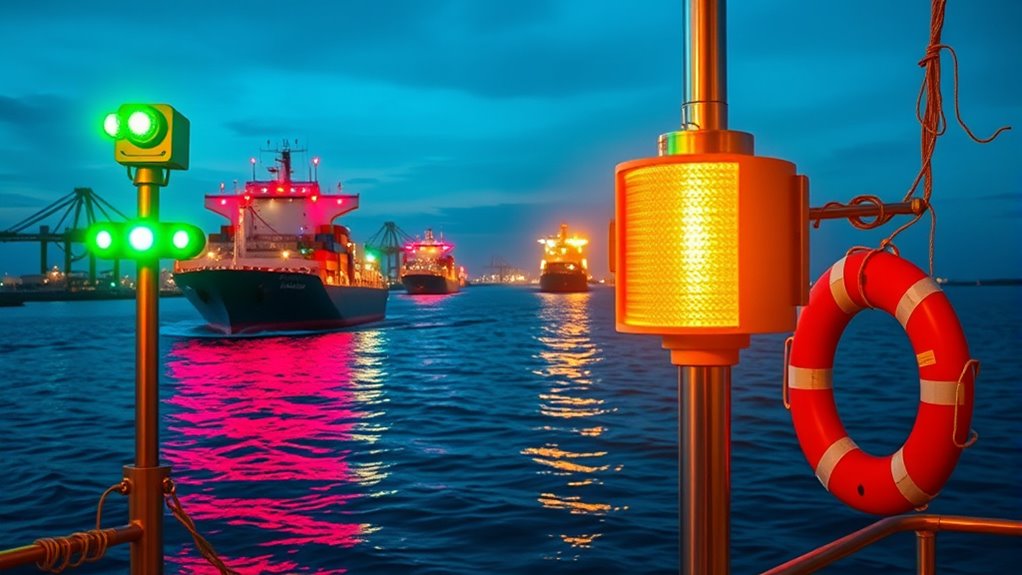When crossing shipping lanes, recognizing and following safety signals is vital for your safety. Look out for navigation lights, sound signals like horns, and visual markers such as buoys to understand nearby vessels’ intentions and movements. Respond promptly to signals indicating course changes or restrictions. Properly interpreting these cues helps prevent collisions and Groundings. Staying alert and using navigation tools ensures you catch signals, even in poor visibility—continue to discover how to stay safe in busy waters.
Key Takeaways
- Recognize vessel navigation lights indicating movement and intentions to determine safe crossing timing.
- Pay attention to sound signals like horns or bells that warn of course changes or stopping.
- Use visual markers such as buoys and beacons to identify safe passages and hazards.
- Maintain proper equipment and stay vigilant to interpret signals clearly, especially in poor visibility conditions.
- Always follow established safety protocols and respond promptly to signals to prevent collisions.

Crossing shipping lanes can be risky if you don’t pay attention to the right safety signals. These lanes are busy with large vessels moving at high speeds, making it essential that you understand and adhere to maritime navigation rules. Safety signals are designed to keep everyone safe by providing clear instructions on when it’s safe to cross or alter your course. Ignoring or misinterpreting these signals can lead to dangerous situations, including collisions or grounding. That’s why your first priority should be to recognize and follow the established safety signals properly.
Always recognize and follow safety signals when crossing busy shipping lanes to prevent accidents and ensure safety.
Maritime navigation relies heavily on a system of standardized signals—lights, sounds, and visual markers—that alert you to ongoing traffic and potential hazards. For example, navigational lights indicate the position and heading of nearby vessels, helping you gauge their movement and intentions. Sound signals, like horns or bells, communicate specific messages such as warnings of maneuvering or restricted visibility. Visual markers, including buoys and flashing beacons, mark safe passages, hazards, and the boundaries of shipping lanes. When crossing these lanes, your ability to interpret these signals accurately is essential for maintaining safety and avoiding misunderstandings with other vessels.
Signal compliance isn’t just about recognizing signals; it’s about responding appropriately. If you see a vessel’s navigation lights indicating it’s underway or restricted in its ability to maneuver, you need to give way and adjust your course accordingly. When sound signals are used—such as a long blast indicating a vessel’s intention to alter course or stop—you must heed these warnings immediately. Failing to comply with maritime signals can result in dangerous situations, especially in congested shipping lanes where quick decisions are essential. Your awareness and timely response can prevent accidents and ensure smooth traffic flow.
Proper maritime navigation and signal compliance also involve staying alert and keeping a good lookout. Weather conditions, like fog or heavy rain, can obscure signals, making it even more important to rely on your navigation tools and communication protocols. Always stay updated with the latest maritime communication standards and ensure your equipment is functioning correctly before entering busy lanes. This proactive approach will help you recognize signals promptly and respond in a way that keeps everyone safe.
Frequently Asked Questions
How Do Weather Conditions Affect Shipping Lane Safety Signals?
Weather impact can seriously affect shipping lane safety signals, making them less reliable when conditions are poor. Heavy rain, fog, or storms can obscure signals or delay their visibility, increasing risks for vessels. You need to stay alert and rely on multiple safety measures, as adverse weather can compromise signal reliability. Always check weather updates and proceed cautiously, understanding that weather impacts the effectiveness of safety signals in maintaining safe navigation.
Are There International Standards for Vessel Signaling in Crossing Lanes?
Did you know that over 70% of maritime accidents involve miscommunication? International standards for vessel signaling in crossing lanes do exist, like the IMO’s COLREGs, which set rules for maritime communication and signal enforcement. These standards help guarantee vessels accurately interpret signals, reducing collisions. You should be aware that adherence is vital worldwide, and proper training on these signals helps maintain safety and smooth navigation across busy shipping lanes.
What Training Is Required for Crew to Interpret Safety Signals Correctly?
You need proper maritime communication training to interpret safety signals correctly. This includes learning signal recognition, such as lights, sounds, and flags, used in various situations. Your crew must understand international standards and specific vessel signaling protocols. Regular drills and refresher courses help make sure everyone responds promptly and accurately, reducing risks. By mastering these skills, you enhance safety at sea and prevent accidents during crossing maneuvers.
How Often Are Safety Signals Reviewed and Updated?
You should review safety signals regularly to guarantee they remain effective. Typically, signal maintenance is scheduled annually, but updates follow protocol changes or new safety standards. During these reviews, you’ll check for signs of wear, clarity, and compliance. Protocol updates are implemented promptly to reflect technological advancements or regulatory changes. Staying proactive with these reviews helps you ensure safety signals work correctly, reducing risks and maintaining safe navigation in shipping lanes.
What Innovations Are Being Developed for Improved Crossing Lane Safety?
You might be surprised, but new innovations are transforming crossing lane safety. Automated systems now detect ships and alert vessels in real-time, reducing accidents. Visual enhancements, like brighter signals and augmented reality displays, improve visibility in all weather conditions. These advancements work together to create smarter, more reliable safety signals, ensuring you and other crew members stay safe while steering through busy shipping lanes. Continuous development keeps safety at the forefront of maritime innovation.
Conclusion
By paying close attention to safety signals, you become a guardian of the seas, guiding vessels safely through bustling lanes like a lighthouse piercing the fog. These signals act as your silent allies, illuminating the path and preventing disaster. Remember, each signal is a beacon of hope amid chaos, a reminder that safe passage depends on your vigilance. Embrace these cues, and you’ll help keep the waters secure — a steady hand in the vast, unpredictable ocean.










